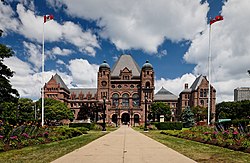A request that this article title be changed to Legislature of Ontario is under discussion . Please do not move this article until the discussion is closed. |
Legislature of Ontario | |
|---|---|
| 44th Parliament of Ontario | |
| Type | |
| Type | |
| Houses | Legislative Assembly |
| Sovereign | Lieutenant Governor (representing the King of Canada) |
| History | |
| Founded | July 1, 1867 |
| Preceded by | Parliament of the Province of Canada |
| Leadership | |
Charles III September 8, 2022 | |
Edith Dumont November 14, 2023 | |

The Legislature of Ontario (also commonly known as the Provincial Parliament of Ontario) is made of two elements: the lieutenant governor (representing the King of Canada), and the Legislative Assembly of Ontario. The Legislature was established on July 1, 1867 following the creation of Ontario as one of the first four provinces of Canada. The seat of the Legislature has been the Ontario Legislative Building in Queen's Park, Toronto since 1893.
Like the Canadian federal government, Ontario uses a Westminster-style parliamentary government, in which members are sent to the Legislative Assembly after general elections. Like all the provincial governments, the concept of responsible government is followed, and the Premier of Ontario and their cabinet is accountable to the Legislative Assembly.

